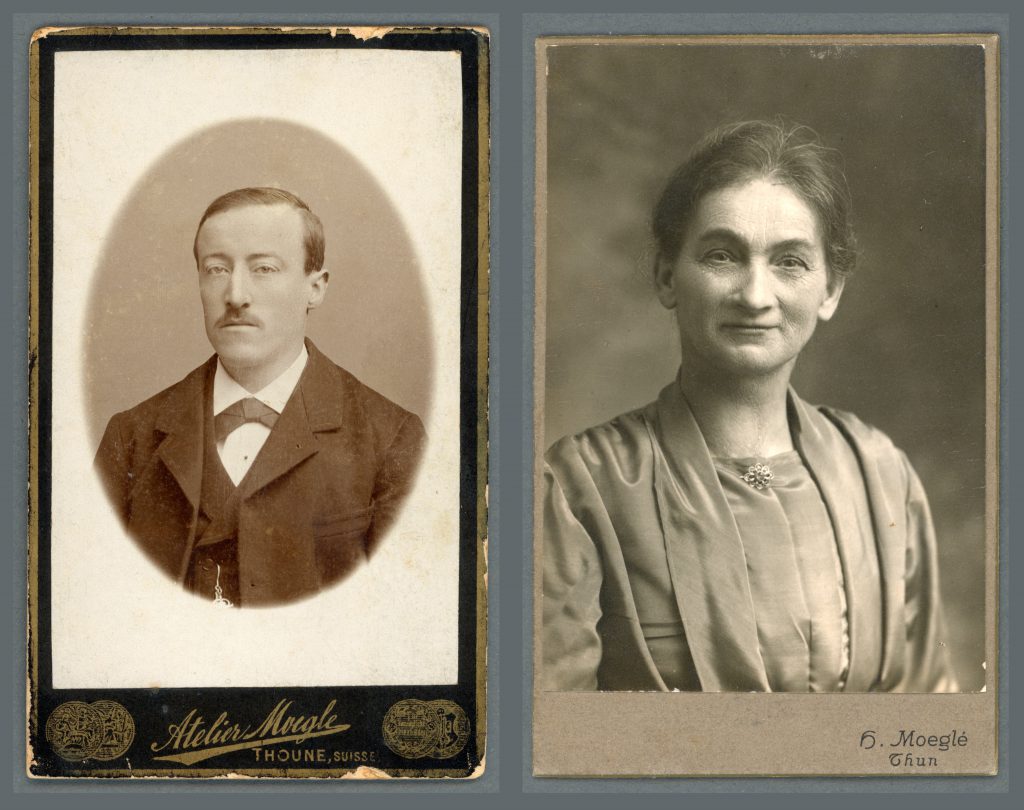
Karl Friedrich Schenk and his wife Magdalena Hossmann (from the archive of Kunstkeramik Luzern A.G., now in the collection of the Thun Castle Foundation)
Andreas Heege, Andreas Kistler, Margret Loder 2021
Karl Friedrich Schenk (17/7/1866-22/5/1919) came from a Heimberg potting family that originated from Röthenbach in the Emmental valley (family tree). His grandfather, Christian Schenk (1790-1861), was a shoemaker, his uncle, also called Christian (1826-1893) worked at a lead-glaze mill in Steffisburg, though it is not known which one (see Frank 2000). This was a specialised craft producing and selling lead-glazes, large amounts of which were needed by the potters, and probably also other glazes and coloured slips. Karl Friedrich Schenk’s father, Samuel Schenk (1835-1904), was a potter, as was his uncle, Jakob Schenk (1842-1904).
Samuel Schenk and his wife Elisabeth Hänni (1837-1911) had ten children. In 1870, Samuel purchased a potter’s workshop with small living quarters which had been built in 1831 at “im Kehr” in Heimberg (now 30 Haslikehrweg) from the heirs to the potter Ulrich Jenni (1820-1868) who had never married.
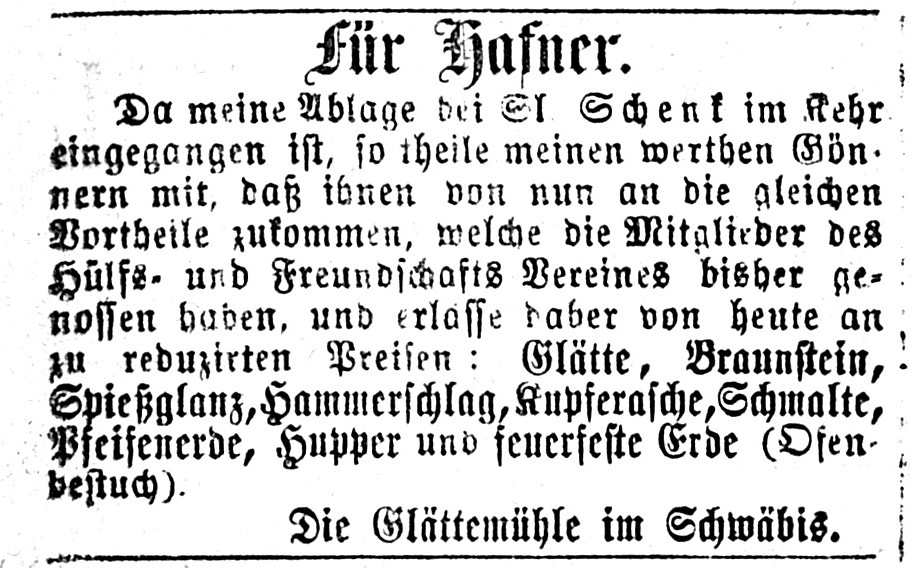
Up to 1876, Samuel Schenk appears to have been the custodian of the materials depot of the Wanzenried lead-glaze mill in Steffisburg-Schwäbis on behalf of the Hilfs- und Freundschaftsverein (benevolent society) of the Heimberg potters (Geschäftsblatt für den oberen Teil des Kantons Bern 23, No. 48, 1876).
It is unclear, how long Samuel actually worked as a potter; upon his death in 1904, he was in fact described as a wainwright. Nor do we know what type of pottery or decorations he produced, as no marked or signed pieces have come to light up to now.
In 1905, the estate including the workshop and barn passed to his widow, Elisabeth Schenk-Hänni (1837-1911), and when she died in 1911, it was divided between Eduard Schenk (carpenter, 1868-?) and Fritz Schenk-Kolb (potter, 1870-1958), Karl Friedrich Schenk’s brothers. At the time, Karl Friedrich and his other surviving siblings were bought out, while the use of the apiary near the homestead was granted free of charge until March 1912.
Four of the six surviving Schenk-Hänni sons also became potters. Gottfried Schenk 1862-1939 did not own a workshop but worked as a potter, and from 1911 at the latest he was employed as a labourer at the brickyard in Steffisburg. Ernst Schenk (1875-1951) was a pottery worker and from 1910 at the latest he became a railway worker. In 1901 he was able to buy a building with three potters’ workshops that had been built in 1835 at 28 Haslikehrweg. It is not known how long he produced pottery there. Fritz Schenk-Kolb (potter, 1870-1958) took over their father’s workshop at 30 Haslikehrweg and Karl Friedrich-Schenk does not appear to have ever had a workshop of his own. However, since there are ceramic objects that bear his signature, we can only assume that he used one of his brothers’ workshops to produce and fire his own wares.
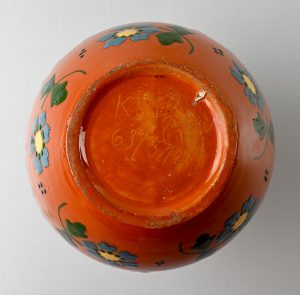
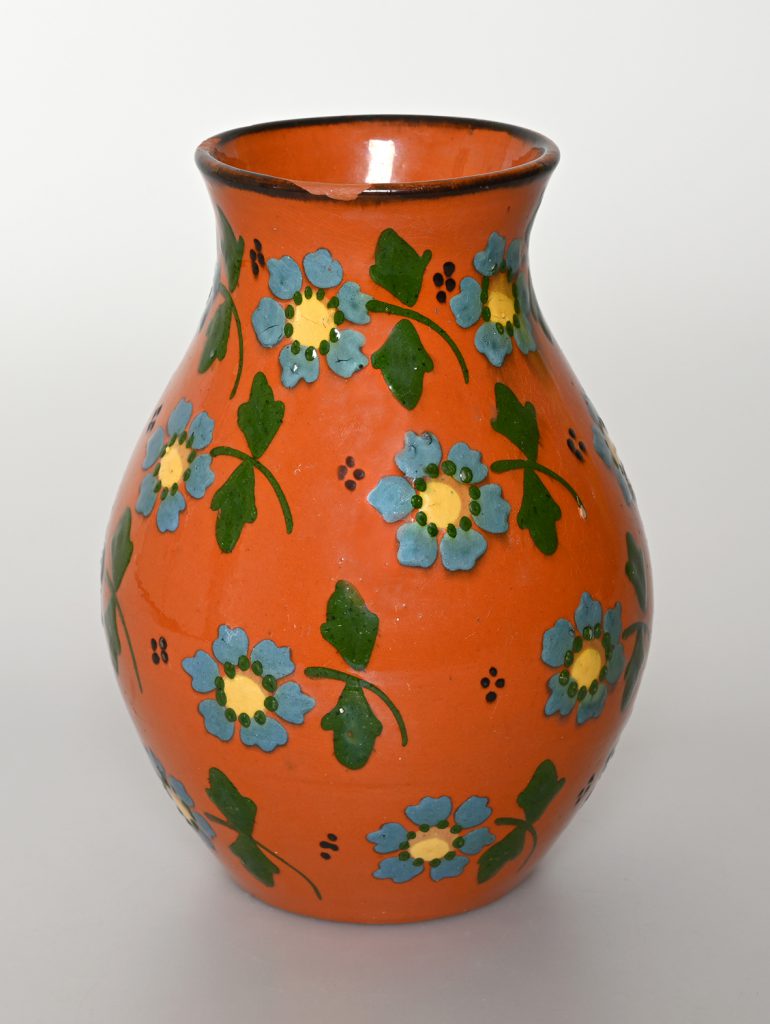
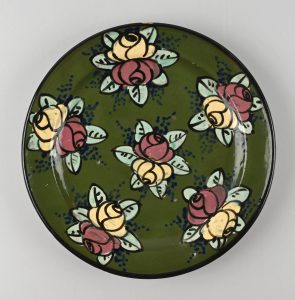
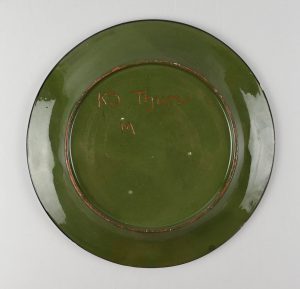
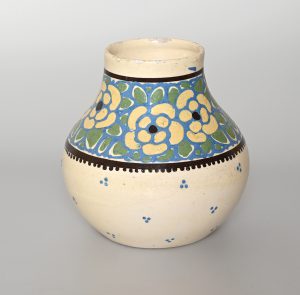
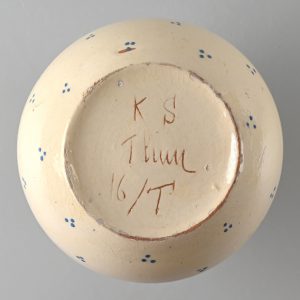
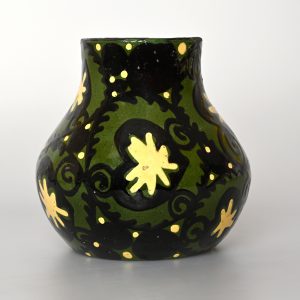
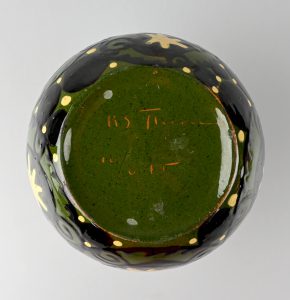
Pottery made by Karl Friedrich Schenk, marked “KS Thun”, private collection in Ebikon and Thun Castle Foundation.

Pottery decorated by Karl Schenk in the collection of the School of Visual Arts and Design Bern and Biel.
The decorations presented here are strongly reminiscent of the patterns taught by the Bernese arts and crafts instructor Paul Wyss at the School of Ceramics in Bern. Together with the Bernese ceramicist, draughtsman and graphic designer Friedrich Ernst Frank, who otherwise worked mainly for the Wanzenried Manufactory in Steffisburg, Wyss also taught the same designs at the School of Pottery and Draughtsmanship in Steffisburg founded in 1906. The course materials from a drawing class taught in Steffisburg by Wyss and Frank have survived. We can only assume that these “modern” motifs in the floral Art Nouveau style were to Karl Friedrich Schenk’s personal taste and that he either painted them himself or had paintresses carry out the work on his behalf for piece rate. We can therefore assume that he was one of a small number of Heimberg potters who were open to stylistic novelties. Other, like-minded potters included Bendicht Loder-Walder under the influence of Nora Gross or Karl Loder-Eyer.
We do not know which house Karl Friedrich Schenk and his family rented. One record mentions a location as “Heimberg, In der Au”, and when his wife died in 1924, her heirs were recorded as living “near the school in Heimberg”..
Various printed sources, his children’s birth announcements and records of the division of his parents’ estate in 1911 identify him as “municipal bailiff” and “beekeeper” (Brunner, J., Adress- Reise- und Reklamen-Taschenbuch für Thun und Berner Oberland Thun, 1908, p. 57). Both of these sidelines probably contributed considerably to the family’s earnings. Another source of income was his wife Magdalena’s work as a caretaker at the school in Heimberg.
Karl Friedrich Schenk had married Magdalena Hossmann (29/10/1868-20/4/1924) from Gerzensee, resident in Aeschlen near Oberdiessbach, on 30/6/1894 in Langnau. The couple had four children, three of which survived to adulthood (family tree): Frieda Schenk (1900-1972), her sister Marie Rosa (1905-?) and their brother Karl (1910-?). Having completed a commercial apprenticeship with the Keller company, a chemical and soap factory in Konolfingen, Frieda Schenk married the ceramicist Emil Loder on 13th March 1925. That same year, the couple took over the running of the company Kunstkeramik Luzern (KERALUZ).

Translation Sandy Haemmerle
References:
Frank 2000
Georg Frank, “Dank dem Gewerbefleiss früherer Jahrhunderte”. Die Nutzung der Wasserkraft in der bernischen Gemeinde Steffisburg vom ausgehenden 13. Jahrhundert bis zur Gegenwart, Thun 2000.

